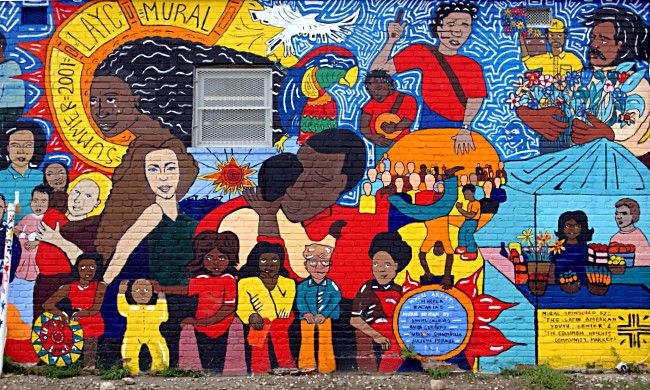
Share On Social!
Hispanic? Latino? Latinx?
People often debate the best term to use when describing the ethnicity of those who trace their heritage from Latin America and Spain, who comprise 18.5% of the U.S. population.
“There’s no correct term to use, and appropriateness varies when using Latino, Hispanic, Latinx, or country of origin,” said Dr. Amelie G. Ramirez, director of Salud America! at UT Health San Antonio.
Let’s talk about the origins of these terms, who uses them, and what the data says about this population’s own preferences.
The Origin of “Latino”
The term we use at Salud America! to describe this group is “Latino.”
“Latino,” or the feminine “Latina,” is used to describe people with ancestry from Latin American countries.
Unlike “Hispanic,” the term “Latino” does not imply the country of origin is Spanish speaking, so it is thought to include people from Brazil and Haiti.
The term is derived from the Spanish word “latinoamericano.”
“Latino” was first used around the 1850s, when “Latin America” was discussed in newspapers, according to researcher Ramón A. Gutiérrez.
“By the late 1850s, Californios were writing in newspapers about their membership in América latina (Latin America) and latinoamerica, calling themselves latinos as the shortened name for their hemispheric membership in la raza Latina (the Latin race),” writes Gutiérrez in his essay, “What’s in a Name? The History and Politics of Hispanic and Latino Panethnicities.”
The term grew in popularity over the 20th century, as some say the term helps convey a shared history of European colonization and a common struggle for national independence.
Latino was officially added to the U.S. Census in 1997.
Up until then, the term “Hispanic” was used.
The Origin of “Hispanic”
Another widely used term to describe this ethnicity is “Hispanic.”
“Hispanic” denotes people ethnically from Spanish-speaking countries in Latin America and Spain.
The term has been used since the 16th century to describe people from the Iberian Peninsula, or Spain and Portugal.
“Hispanic” was also used colloquially around the 1850s after the Mexican American war, but not officially by the U.S. government until the 1970s.
During the U.S. Civil Rights Movement of the 1960s, people of Latin American descent realized that a broader term might be more effective to raise attention for civil rights issues.
It worked, and in 1976, after decades of lobbying, Congress passed a law mandating collection of information about U.S. residents of Mexican, Puerto Rican, Cuban, Central American, South American and other Spanish-speaking country origins.
This collective group was broadly called “Hispanic.” The term was added to Census questionnaires in 1980.
“Before 1980, those of Latin American descent were considered Spanish-speaking, having Spanish origin or white on the census,” according to History.com. “The latter frustrated Mexican-American activists because they had no data to prove that their communities needed resources for programs, such as job training.”
While “Latino” and “Hispanic” are the most commonly used terms, a new label has emerged over recent years that is gaining popularity and recognition.
The Origin of “Latinx”
“Latinx” is a newer term used to describe this group.
The term is a gender-neutral form of “Latino” or “Latina” that has caught on particularly among younger generations and the LGBTQ+ community.
“Latinx” is thought to have been coined in 2004.
But after the 2016 Pulse Nightclub Shooting in Orlando, Florida that primarily targeted LGBTQ+ Latinos, the term became more widely recognized and used.
“We found that after the Pulse Massacre, Latinx was thrust into larger use,” said Alan Aja, a professor in the Puerto Rican and Latin Studies department at Brooklyn College, according to Good Housekeeping. “Perhaps as an act of resistance, solidarity and visibility of non-binary gender identities as the LGBTQ+ [community] was being attacked.”
Some have criticized the term for being difficult for Spanish speakers to pronounce and that it goes against grammatical rules in Spanish.
Some have even advocated for “Latine” as a gender-neutral identifier.
Which of Hispanic, Latino, and Latinx is Used More?
Many use Latino, Latinx, and Hispanic interchangeably.
But there is clear data that some are used more widely than others.
When comparing data from Google searches on Aug. 31, 2021, the terms have the following search results:
- Latino – 614,000,000
- Hispanic – 211,000,000
- Latinx – 16,300,000
While “Latino” has the most search results and “Latinx” the least, this isn’t necessarily indicative of which term is more commonly used by this group.
Which of Hispanic, Latino, and Latinx is Preferred by This Ethnicity?
Latinos have mixed views on how they prefer to describe their identity, according to a 2020 report by PEW Research:
- 50% most often describe themselves by their family’s country of origin (Mexico, Cuba, etc.)
- 23% use the terms Latino or Hispanic
- 23% most often describe themselves as American
Many people also don’t have a preference on whether they use “Hispanic” or “Latino:”
- 51% have no preference
- 32% prefer Hispanic
- 15% prefer Latino
Even fewer people use “Latinx,” according to PEW:
- 76% of Latinos have not heard of the term “Latinx”
- 20% have heard of “Latinx,” but do not use it
- 3% use “Latinx” to describe themselves
Those who have heard of Latinx are mostly young women ages 18 to 29. So this term may be more widely used with future generations.
Still, most people in this group prefer to identify by their nationality of origin.
“When describing their identity, more than half (54%) of Hispanics say they most often use the name of their ancestors’ Hispanic origin (such as Mexican, Dominican, Salvadoran or Cuban),” according to PEW.

Latinos may find pride in their nationality of origin or want to highlight the diversity within the group.
“Personally, I identify as Dominican because I am from the Dominican Republic. I stay away from using panethnic labels to avoid disregarding the cultural differences among the various Latin American and Spanish-speaking countries,” said Rosa Del Saz, senior vice president of finance and operations at America Magazine.
How someone from this group chooses to identify is often a personal choice.
“No matter which term is used, people often disagree. It’s an emotionally charged topic and there are important usage variations depending on the region, generation, political inclination, etc. Before using a specific term, inform yourself, and know why you are using it,” according to Generating Engagement and New Initiatives for All Latinos (GENIAL).
It’s always best to ask and not make assumptions.
Growth and Age: A Unique Characteristic of the Hispanic, Latino, Latinx Population
Latinos are unique among demographic groups because of their growth.
In 2019, Latinos became the second largest racial/ethnic group. They comprise 18.5% of the population with about 60,572,237 people.
However, even as the Latino population continues to rise, growth is slowing down, according to an analysis of the Census Bureau data by PEW.
The average annual growth rate for U.S. Latinos:
- 8%, 1995-2000
- 8%, 2000-2005
- 4%, 2005-2010
- 1%, 2010-2015
- 9%, 2015-2019
Also, the median age of Latinos is young compared to other demographic groups.
But is gradually getting older. In 2019, the median age for U.S. Latinos was 29.8 years, up from 27.3 in 2010.
“Latinos are among the youngest racial or ethnic groups in the U.S. but saw one of the largest increases in median age over the past decade,” according to PEW.
Language: A Unique Characteristic of the Hispanic, Latino, Latinx Population
The diversity of Latinos is another element that makes this demographic unique.
Latinos are also unique from other groups through their language usage.
As of 2015, 73% of Latinos speak Spanish, which is down from 78% in 2006, according to PEW.
Latinos are also increasingly bilingual in Spanish and English, as 50% of Latino adults who are the children of immigrant parents are bilingual, according to PEW.
However, many Latinos say speaking Spanish is not necessary to be considered a Latino.
“On the one hand, Spanish is an important part of Latino culture and identity, with 95% of Latinos saying it is important for future generations to speak Spanish. At the same time, most Latino adults say it is not necessary to speak Spanish to be considered Latino. According to a recent Pew Research Center survey of Latinos, 71% of Latino adults hold that view while 28% say the opposite,” writes Mark Hugo Lopez, according to PEW.

Denise Hernández, a Chicana activist in San Antonio, was not taught Spanish by her family because they thought she would be better off not knowing it.
“My grandpa and my grandma didn’t speak Spanish in school because they were beaten for it,” Hernández said.
While speaking Spanish isn’t a requirement for being a Latino, being from a country of Latin American or Spanish origin is often considered to be one.
Diversity: A Unique Characteristic of the Hispanic, Latino, Latinx Population
Within the U.S., Latinos can trace their heritage to many different nationalities.
The following Latin American nationalities are the most common for U.S. Latinos, according to Statista:
- Mexican – 62%
- Puerto Rican – 9.7%
- Cuban – 3.9%
- Salvadoran – 3.8%
- Dominican – 3.5%
Other Latin American nationalities make up much smaller percentages, and many cities and states have pockets of Latin American communities scattered throughout them.
That’s why Giselle Rincon created a space for Venezuelans to celebrate their culture and give back to their home country through her nonprofit, Venezuela’s Voice in Oregon.
“[Venezuelan Immigrants in the U.S.] are the minority of the minority. In Oregon, a lot of people think if you speak Spanish, you come from Mexico. But actually, no, there are 21 countries that speak Spanish, and Venezuela is one of them,” Rincon said.
While the diversity within the Latino community makes it unique and worth celebrating, we also see many inequities and disparities that need to be addressed.
“The importance of solidarity is basic in the human being. Living the two sides of the coin, the privileged and the not-so-privileged, gives me a more human view of how people can discriminate to each other based on nonsense stereotypes,” Rincon said.
What Health Disparities Impact the Hispanic, Latino, Latinx Population?
The rise of the Latino population across the United States makes it imperative to address health gaps in this population.
Unfortunately, the disparities are quite large, according to research from Salud America!
Latinos have less access to healthy food and places to safely practice physical activity:
- Latino neighborhoods have 1/3 as many supermarkets as non-Latino ones.
- Fewer Latinos (70%) than whites (82.5%) say their neighborhood has safe play spaces for kids.
- Latino infants were twice as likely to be fed sugary drinks than their non-Latino peers. Latino kids who consumed sugary drinks had 2.3x the odds of severe obesity.
Latinos are more likely to suffer from mental health issues and childhood trauma:
- 22% of Latino youth have depressive symptoms.
- 8% of Latino kids suffer at least one adverse childhood experience (ACE), such as poverty, neglect, abuse, household dysfunction (divorce, violence, etc.). 28% of Latino kids suffer four or more adverse experiences.
- Fewer Latino parents reported that their child had ever used mental health care services (8%) compared to white children (14%).
Latinos also face economic issues that put them at risk for poverty:
- Latino families are burdened by high housing costs, eviction, and displacement. The percentage of Latinos who are “housing cost burdened,” spending 30% or more of household income on housing costs, grew from 42.4% in 2000 to 56.9% in 2015.
- Latino families are more likely to live in poverty than white families. Child poverty rates are more than twice as high for Latino children than White children (23.7% vs 8.9%).
- Many Latinos lack health insurance. Despite the Affordable Care Act, the uninsured rate remains higher among Latino (25.1%) than White adults (8.5%).
COVID-19 is also disproportionately affecting Latinos:
- Latinos currently comprise 26% of COVID-19 cases in the United States, second only to Whites (50.1%), according to CDC data on Aug. 4, 2021.
- Latinos make up 34.2% of COVID deaths, according to the CDC’s weighted population distributions.
- Latinos are getting vaccinated for COVID-19 at much lower rates compared to other groups.
It’s clear that many disparities affect Latinos in the U.S., and that advocating for health equity is an important step in becoming a cohesive society.
How Can I Advocate for the Hispanic, Latino, and Latinx Population?
You can make a difference by advocating for health equity in your own community.
Select your county name and get a customized Health Equity Report Card from Salud America! at UT Health San Antonio, which shows your area stacks up in housing, transit, poverty, health care, food, and other health equity issues compared to your state and nation.
The Health Equity Report Card auto-generates local data with interactive maps and comparative gauges, which can help you visualize and explore health inequities.
Get your Health Equity Report Card!
Explore More:
Overcoming Harmful BiasesBy The Numbers
3
Big Excuses
people use to justify discriminatory behavior



